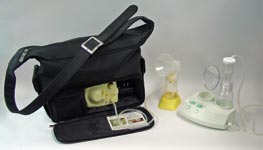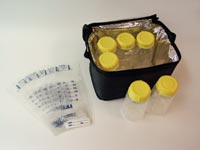
Pumping and milk storage
Pumping
If you are unable to breastfeed your baby directly, it is important to remove milk during the times your baby normally would feed. This will help you continue to make milk. Before you express breast milk, be sure to wash your hands with soap and water, or a waterless hand cleanser if your hands don’t appear dirty. The breast and nipples do not need to be washed before pumping. Also, make sure the area where you are expressing is clean.
If you need help to get your milk to start flowing, have one of the following items nearby — a picture of your baby, a baby blanket, or an item of your baby’s clothing that has his or her scent on it. You can also apply a warm moist compress to the breast, gently massage the breasts, or sit quietly and think of a relaxing setting.
| Type | How it works | What's involved | Average cost |
|---|---|---|---|
| Hand expression | You use your hand to massage and compress your breast to remove milk. |
|
Free, unless you need help from a breastfeeding professional who charges for her services. |
| Manual pump | You use your hand and wrist to operate a hand-held device to pump the milk. |
|
$30 to $50 |
| Automatic, electric breast pump | Runs on battery or plugs into an electrical outlet. |
|
$150 to over $250 |
Hospital-grade electric pumps can be rented from a lactation consultant at a local hospital or from a breastfeeding organization. These pumps work well for establishing milk supply when new babies can’t feed at the breast. Mothers who have struggled with other expression methods may find that these pumps work well for them.
 |
 |
 |
| Electric pumps | Milk storage bags and bottles | Manual pump |
You can keep germs from getting into the milk by washing your pumping equipment with soap and water and letting it air dry.
Storage of breast milk
Breast milk can be stored in clean glass or hard BPA-free plastic bottles with tight fitting lids. You can also use milk storage bags, which are made for freezing human milk. Do not use disposable bottle liners or other plastic bags to store breast milk.
After each pumping
- Label the date on the storage container. Include your child’s name if you are giving the milk to a childcare provider.
- Gently swirl the container to mix the cream part of the breast milk that may rise to the top back into the rest of the milk. Shaking the milk is not recommended — this can cause a breakdown of some of the milk’s valuable components.
- Refrigerate or chill milk right after it is expressed. You can put it in the refrigerator, place it in a cooler or insulated cooler pack, or freeze it in small (2 to 4 ounce) batches for later feedings.
Tips for freezing milk
- Wait to tighten bottle caps or lids until the milk is completely frozen.
- Try to leave an inch or so from the milk to the top of the container because it will expand when freezing.
- Store milk in the back of the freezer — not in the freezer door.
Tips for thawing and warming up milk
- Clearly label milk containers with the date it was expressed. Use the oldest stored milk first.
- Breast milk does not necessarily need to be warmed. Some moms prefer to take the chill off and serve at room temperature. Some moms serve it cold.
- Thaw frozen milk in the refrigerator overnight, by holding the bottle or frozen bag of milk under warm running water, or setting it in a container of warm water.
- Never put a bottle or bag of breast milk in the microwave. Microwaving creates hot spots that could burn your baby and damage the components of the milk.
- Swirl the milk and test the temperature by dropping some on your wrist. It should be comfortably warm.
- Use thawed breast milk within 24 hours. Do not refreeze thawed breast milk.
| Place | Temperature | How long | Things to know |
|---|---|---|---|
| Countertop, table | Room temp (60°F - 85°F) | Up to 3-4 hours is best. Up to 6-8 hours is okay for very clean expressed milk. |
Containers should be covered and kept as cool as possible; covering the container with a clean cool towel may keep milk cooler. Throw out any leftover milk within 1 to 2 hours after the baby is finished feeding. |
| Smaller cooler with a blue-ice pack. | 59°F | 24 hours | Keep ice packs in contact with milk containers at all times; limit opening cooler. |
| Refrigerator | 39°F or colder | Up to 72 hours is best. Up to 5-8 days is okay for very clean expressed milk. |
Store milk in the back of the main body of the refrigerator. |
| Freezer | 0°F or colder | Up to 6 months is best. Up to 12 months is okay. |
Store milk toward the back of the freezer where temperature is most constant. Milk stored at 0°F or colder is safe for longer durations, but the quality of the milk might not be as high. |
| Room temperature (60°F to 85°F) |
Refrigerator (39°F or colder) |
Any freezers | |
|---|---|---|---|
| Thawed breast milk | Up to 1-2 hours is best. Up to 3-4 hours is okay. |
24 hours | Do not refreeze |
More information on pumping and milk storage
Read more from womenshealth.gov
-
Your Guide to Breastfeeding — This easy-to-read publication provides women the how-to information and support needed to breastfeed successfully. It explains why breastfeeding is best for baby, mom, and society and how loved ones can support a mother's decision to breastfeed. Expert tips and illustrations help new moms learn how to breastfeed comfortably and how to overcome common challenges.
http://www.womenshealth.gov/publications/our-publications/breastfeeding-guide/
Explore other publications and websites
-
A Breastfeeding Checklist: Are You Nursing Correctly? (Copyright © American Academy of Pediatrics) — This brief checklist explains what you need to do to ensure you are nursing correctly. It also offers signs of correct and incorrect breastfeeding.
http://www.healthychildren.org/English/ages-stages/baby/breastfeeding/pages/A-Breastfeeding-Checklist-Are-You-Nursing-Correctly.aspx
-
Breastfeeding — Proper Handling and Storage of Human Milk — The CDC provides guidelines for how to properly store fresh human breast milk for full term infants, based on research conducted on the safety of breast milk at different temperatures over time. This fact sheet also provides information on how to prepare and thaw breast milk for later use.
http://www.cdc.gov/breastfeeding/recommendations/handling_breastmilk.htm
-
Breastfeeding: How to Pump and Store Your Breast Milk (Copyright © American Academy of Family Physicians) — This publication explains when you should start pumping, how often and for how long you should pump, and how much milk you should expect to get. It also provides guidelines for storing breast milk.
http://familydoctor.org/online/famdocen/home/women/pregnancy/birth/828.html
-
What Are the LLLI Guidelines for Storing My Pumped Milk? (Copyright © La Leche League International) — This article details specific instructions for breast milk storage, as well as the visual characteristics and odor of human milk.
http://www.llli.org/FAQ/milkstorage.html
Connect with other organizations
-
American Academy of Family Physicians
http://familydoctor.org/online/famdocen/home.html
-
American Academy of Pediatrics
http://www.aap.org/
-
Breastfeeding Basics
http://www.breastfeedingbasics.org/
-
Centers for Disease Control and Prevention, HHS
http://www.cdc.gov/
-
International Lactation Consultant Association (ILCA)
http://www.ilca.org
-
La Leche League International
http://www.llli.org/
-
National Healthy Mothers, Healthy Babies Coalition
http://www.hmhb.org/
-
Special Supplemental Nutrition Program for Women, Infants and Children, (WIC) USDA
http://www.fns.usda.gov/wic/
-
Womenshealth.gov, OWH, HHS
http://www.womenshealth.gov/
-
World Alliance For Breastfeeding Action
http://www.waba.org.my/
Content last updated August 1, 2010.
Resources last updated August 1, 2010.
womenshealth.gov
A federal government website managed by the Office on Women's Health in the Office of the Assistant Secretary for Health at the U.S. Department of Health and Human Services.
200 Independence Avenue, S.W. • Washington, DC 20201


 Text size
Text size Email
Email
